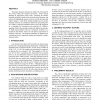Free Online Productivity Tools
i2Speak
i2Symbol
i2OCR
iTex2Img
iWeb2Print
iWeb2Shot
i2Type
iPdf2Split
iPdf2Merge
i2Bopomofo
i2Arabic
i2Style
i2Image
i2PDF
iLatex2Rtf
Sci2ools
VISUALIZATION
1997
IEEE
1997
IEEE
Strategies for effectively visualizing 3D flow with volume LIC
This paper discusses strategies for effectively portraying 3D flow using volume line integral convolution. Issues include defining an appropriate input texture, clarifying the distinct identities and relative depths of the advected texture elements, and selectively highlighting regions of interest in both the input and output volumes. Apart from offering insights into the greater potential of 3D LIC as a method for effectively representing flow in a volume, a principal contribution of this work is the suggestion of a technique for generating and rendering 3D visibilityimpeding “halos” that can help to intuitively indicate the presence of depth discontinuities between contiguous elements in a projection and thereby clarify the 3D spatial organization of elements in the flow. The proposed techniques are applied to the visualization of a hot, supersonic, laminar jet exiting into a colder, subsonic coflow.
Appropriate Input Texture | Line Integral Convolution | Paper Discusses Strategies | Visualization | VISUALIZATION 1997 |
Related Content
| Added | 06 Aug 2010 |
| Updated | 06 Aug 2010 |
| Type | Conference |
| Year | 1997 |
| Where | VISUALIZATION |
| Authors | Victoria Interrante, Chester Grosch |
Comments (0)

